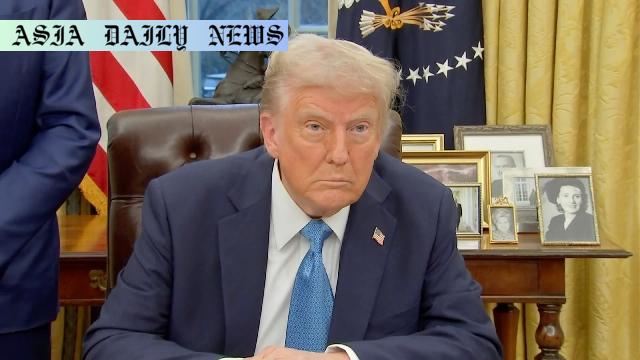Tariffs: Trump imposes 25% tariffs on Mexico, Canada, and 10% on China due to their alleged links to illegal fentanyl distribution.
The US is imposing 25% tariffs on Mexico and Canada.
A 10% tariff on China is tied to alleged fentanyl distribution.
Future tariffs may target oil, natural gas, semiconductors, and pharmaceuticals.
President Trump emphasizes tariffs’ role in economic growth and strength.
Potential tariffs on the EU for its trade deficit with the US are hinted.

Introduction: A New Trade Policy Era
In a decisive and controversial move, the United States, led by President Donald Trump, has introduced a series of tariffs targeting its closest neighbors—Mexico and Canada—with a 25% tariff rate. Announced on Friday by White House Press Secretary Karoline Leavitt, these measures aim to address various economic and national issues, including the distribution of fentanyl in the United States. China’s exports have also been targeted with a 10% tariff due to alleged links to the illegal drug trade. With more tariff plans under consideration, the policy signals a significant shift in the Trump administration’s trade strategies.
Immediate Tariff Implications for Mexico and Canada
The most immediate and impactful change involves a 25% tariff imposed on goods from Mexico and Canada. These two nations, long considered essential trading partners through treaties like the USMCA (United States-Mexico-Canada Agreement), are now facing steep financial implications due to potentially increased costs of trade. The move is particularly notable given President Trump’s campaign pledge to implement widespread protections for American industries by restructuring trade agreements and addressing what he perceives as trade imbalances.
Targeting China: A Focus on Fentanyl
Equally explosive is the Trump administration’s imposition of a 10% tariff on China, citing the country’s alleged role in sourcing and distributing fentanyl into the United States. The opioid epidemic has become a crisis of monumental proportions in the US, with millions of lives impacted by addiction. By holding China accountable, this tariff is both an economic and symbolic action to emphasize the administration’s determination to tackle domestic issues affected by international dynamics.
Future Tariff Plans and Key Industries in the Spotlight
President Trump has indicated that more tariffs are on the horizon, further signaling a tough trade approach. The administration is considering levies on oil and natural gas imports, with implementation likely around February 18. Moreover, sectors like semiconductors and pharmaceuticals are expected to come under scrutiny. While no specific percentages or countries were outlined, these industries could face substantial financial adjustments in the near future.
Potential Impact on Steel and Aluminum
Trump has also hinted at revisiting tariffs on steel and aluminum imports, a move reminiscent of his actions during his first term in office. These earlier tariffs have been credited with reviving parts of the US steel industry but have also been criticized by trading partners and domestic businesses for raising costs and complicating supply chains. The president’s reiteration of the ‘cheap steel’ flooding narrative suggests a continued commitment to supporting domestic manufacturing as a cornerstone of his economic agenda.
Europe in Tension: Talks of Tariffs on the EU
Another dimension of the tariff strategy involves Europe. President Trump has unequivocally stated an intention to impose tariffs on imports from the European Union, citing a ‘tremendous deficit’ and years of alleged unfair trade practices. While no further details were disclosed, the statement has added another layer of uncertainty to international economic relations.
Global and Domestic Reactions
Reactions to these announcements have been mixed. Economists and trade experts have debated the potential effectiveness of such tariffs in achieving their stated aims. Some argue that using tariffs as leverage can force beneficial renegotiations of trade agreements, while others warn of retaliatory measures by affected countries and the potential escalation of trade wars. Domestically, affected industries face both uncertainties and opportunities depending on their reliance on imports and exports.
Conclusion: A Controversial but Bold Approach
President Trump has reaffirmed his commitment to using tariffs as a tool to reshape international trade relationships and bolster domestic industries. The latest tariffs targeting Mexico, Canada, and China represent a continuation of this strategy, with more plans hinting at further disruptions in the trade landscape. Whether these measures lead to the intended economic strengthening or result in unintended consequences remains to be seen. Ultimately, the administration’s bold moves are certain to leave a lasting impact on global trade dynamics.



Commentary
A Strong but Divisive Move
President Trump’s decision to impose widespread tariffs comes with both acclaim and criticism. Supporters view this as a necessary step to even the playing field for American workers and industries. By directly targeting nations connected to key economic issues, the administration seeks to tackle challenges like fentanyl distribution and the flooding of cheap products into the market. However, the divisiveness arises from the ripple effects such tariffs tend to trigger across industries and consumer markets.
The Complexity of Global Trade
While tariffs are aimed at protecting domestic industries, they often come with unintended consequences. For instance, industries reliant on imported raw materials may face increased production costs, which could lead to higher consumer prices. Retaliatory tariffs by countries like China, Mexico, and Canada are also a looming concern, as they can disrupt the finely balanced ecosystem of global trade. It’s a complex dynamic where initial actions often sow further complications.
Looking Ahead
With additional tariffs planned for February and beyond, it’s crucial to consider the implications on broader sectors such as oil, semiconductors, and pharmaceuticals. These are industries deeply interwoven with global supply chains. Careful thought must be given to avoid a cascading effect of retaliation and economic strain. While President Trump’s policies undoubtedly aim to strengthen the US economy, the road to such goals may not be without disruption and controversy.
In the end, Trump’s bold tariffs serve as a reminder of the complex interplay between politics, economics, and international relations. The outcomes, whether positive or negative, will undoubtedly shape the global trade outlook for years to come.